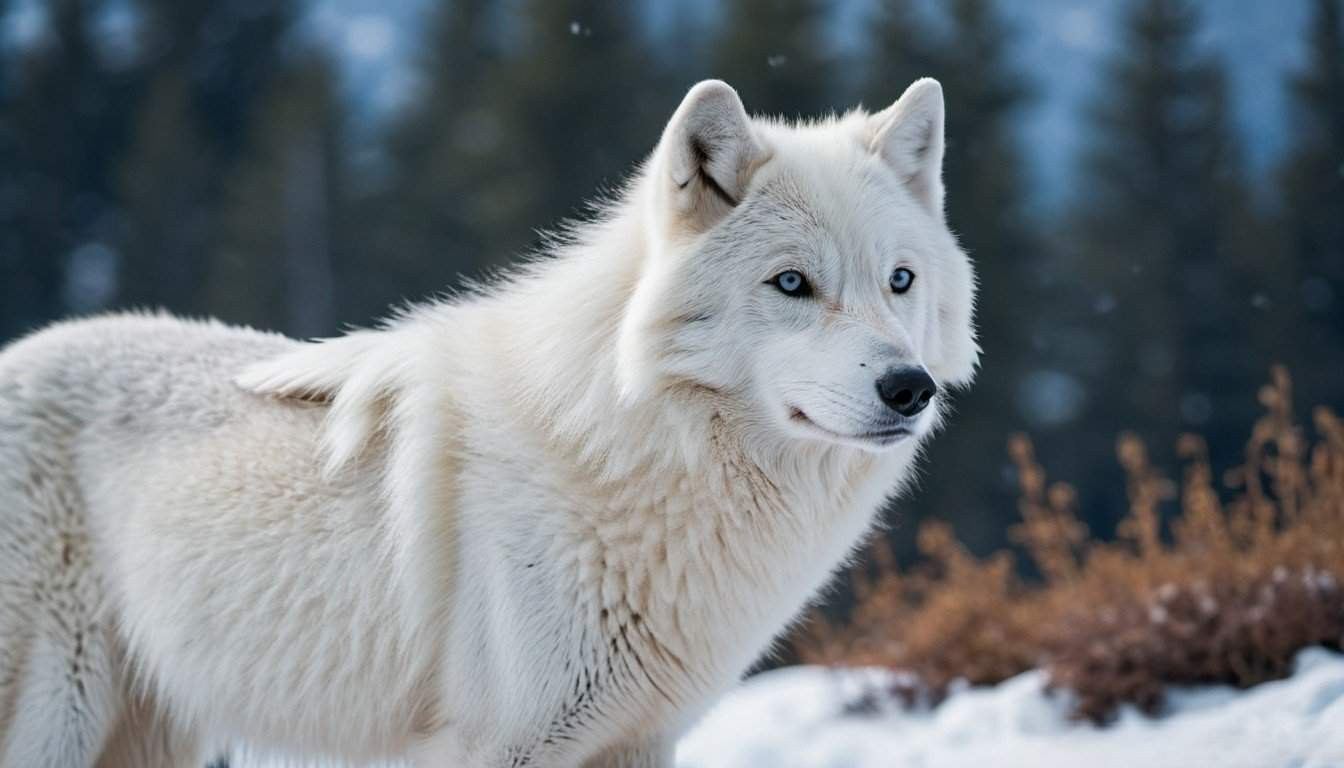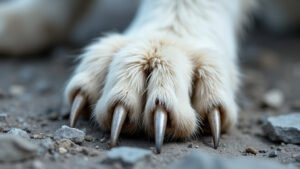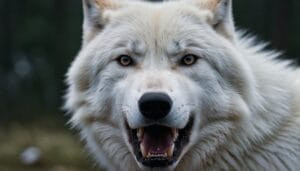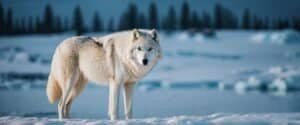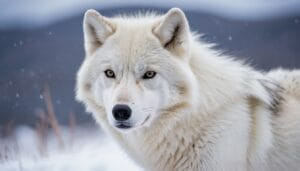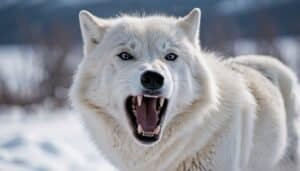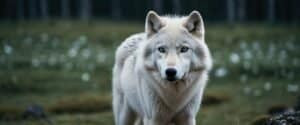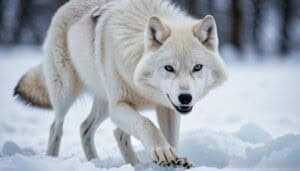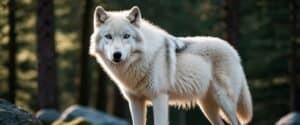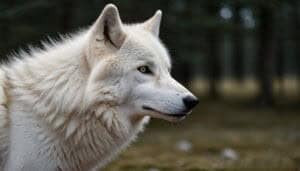Introduction
Understanding the fur thickness of Arctic wolves is crucial to comprehending how these magnificent creatures survive in some of the harshest climates on Earth. In this article, we will explore various aspects of Arctic wolf fur
We begin by examining the average thickness and how it compares to other wolf species. Next, we delve into the variations in fur thickness, including seasonal changes, differences between genders, and age-related variations. We then discuss the adaptations and benefits of having thick fur, such as insulation properties, camouflage, and overall health
Finally, we address the impact of climate change on fur thickness, looking at historical changes and future predictions. Join us as we uncover the fascinating details of Arctic wolf fur
Average Thickness and Comparisons
To truly appreciate the resilience of the Arctic wolf, it’s essential to understand the nature of its fur. The thickness of an Arctic wolf’s fur is a vital adaptation that allows it to thrive in the extreme cold of the Arctic
In this section, we’ll explore how thick this fur really is, how it is measured, and how it compares to the fur of other wolf species
Measuring the Fur Thickness in Centimeters
The fur of an Arctic wolf is incredibly dense and layered, providing excellent insulation. Typically, the fur thickness is measured in centimeters. On average, the fur of an Arctic wolf can be about 5 to 7 centimeters thick. This includes both the outer guard hairs and the dense undercoat
The guard hairs are long, coarse, and water-resistant, providing the first line of defense against the elements. Beneath these guard hairs lies the undercoat, which is soft, fluffy, and traps air for insulation. This double-layered fur system ensures that Arctic wolves remain warm even when temperatures plummet below -30°C (-22°F)
Scientists measure the fur thickness using precise tools like calipers and digital measuring devices. They often take multiple measurements across different parts of the body, such as the back, sides, and belly, to get an accurate average
Comparative Analysis with Other Wolf Species
When comparing the fur thickness of Arctic wolves to other wolf species, the difference is striking. Gray wolves, for example, have a fur thickness that ranges from 3 to 5 centimeters, which is significantly less than that of their Arctic counterparts. This difference is primarily due to the distinct habitats and environmental conditions each species faces
The thicker fur of the Arctic wolf is an evolutionary adaptation to the extreme cold of the Arctic tundra. Gray wolves, on the other hand, inhabit a variety of environments, including forests, grasslands, and deserts, where such thick insulation isn’t as crucial
Additionally, the coloration and texture of the fur can vary between species. Arctic wolves have predominantly white fur, which not only provides camouflage in the snowy landscape but also reflects sunlight, helping to regulate their body temperature
In contrast, gray wolves have fur that can range from gray to brown to black, offering camouflage in more diverse environments
Variations in Fur Thickness
Arctic wolf fur isn’t uniform throughout the year or across different individuals. These variations are crucial for their survival and adaptation to the ever-changing Arctic environment. In this section, we will delve into the seasonal changes in fur thickness, differences between males and females, and how fur thickness varies with age
Seasonal Changes in Fur Thickness
One of the most fascinating aspects of Arctic wolf fur is its ability to change with the seasons. During the harsh winter months, their fur becomes significantly thicker, providing extra insulation against the extreme cold. This winter coat is composed of a denser undercoat and longer guard hairs, which trap heat close to the body and protect against biting winds
As spring approaches and temperatures begin to rise, Arctic wolves undergo a molting process. They shed their thick winter coat to adapt to the milder conditions. The summer fur is much lighter and shorter, reducing the risk of overheating
This seasonal adaptation ensures that Arctic wolves maintain optimal body temperature and energy efficiency throughout the year
The molting process is a gradual one, typically starting in late spring and continuing into early summer. During this period, patches of fur may fall out, and the new, lighter coat begins to grow in. This process is essential for their health, as carrying a heavy winter coat into the warmer months would be detrimental
Differences Between Male and Female Arctic Wolves
While the general characteristics of Arctic wolf fur are consistent across the species, there can be notable differences between males and females. Males tend to have slightly thicker fur compared to females, providing additional protection and insulation
This difference is thought to be an adaptation linked to their roles within the pack and their larger body size
Male Arctic wolves, being generally larger and more dominant, often take on more demanding roles in hunting and protecting the pack. The thicker fur helps them endure longer periods of exposure to harsh weather while performing these tasks
Females, although their fur is slightly less thick, still possess highly effective insulation suitable for their needs, including nurturing pups
These differences are subtle but important, reflecting the nuanced ways in which evolution has tailored the Arctic wolf’s fur to meet the specific demands placed on different members of the pack
Fur Thickness Across Different Ages
The age of an Arctic wolf also influences the thickness and quality of its fur. Pups are born with a soft, thin coat that provides initial warmth but is not as robust as the fur of adult wolves. As they grow, their fur thickens, and they develop the double-layered system characteristic of adults
Juvenile wolves, transitioning from pups to adults, experience significant changes in their fur. By the time they are ready to join hunting activities, their fur has thickened considerably to provide the necessary protection against the cold. This process is crucial for their survival during their first winter
Older wolves, on the other hand, might experience a slight thinning of their fur as they age. This can be due to a variety of factors, including reduced overall health and changes in metabolic rates
However, even older wolves maintain a sufficient level of fur thickness to survive in the Arctic environment
Adaptations and Benefits of Thick Fur
The thick fur of the Arctic wolf is more than just a feature of its appearance; it’s a critical adaptation that plays a vital role in its survival
In this section, we’ll delve into the specific adaptations that make this fur so effective, including its insulation properties, its role in camouflage, and its overall importance to the health and well-being of the Arctic wolf
Insulation Properties and Adaptations for Extreme Cold
Arctic wolves have developed an extraordinary fur structure that provides exceptional insulation. This adaptation is crucial for surviving in the frigid Arctic temperatures, which can drop well below -30°C (-22°F). The key to this insulation lies in the dual-layer composition of their fur
The outer layer, known as guard hairs, is long, coarse, and water-resistant. These guard hairs act as the first line of defense against snow and wind, preventing moisture from reaching the skin. Beneath this protective layer is the undercoat, which is dense, soft, and incredibly insulating
The undercoat traps air close to the wolf’s body, creating a thermal barrier that retains body heat
In addition to these structural features, the Arctic wolf’s fur has a unique ability to fluff up, increasing its insulation capacity. When the wolf fluffs its fur, it traps even more air, enhancing its ability to stay warm in extremely cold conditions
This adaptation is essential for maintaining their core body temperature during long periods of exposure to severe weather
Role in Camouflage and Natural Habitat
Another significant benefit of the Arctic wolf’s thick fur is its role in camouflage. The white or off-white color of their fur blends seamlessly with the snowy landscape of the Arctic, providing excellent concealment from both prey and predators. This camouflage is vital for their hunting strategy, allowing them to approach their prey undetected
The texture and length of the fur also contribute to this camouflage. The guard hairs reflect sunlight, which can help to break up the wolf’s outline and make it less visible in the bright, snowy environment. This natural disguise not only aids in hunting but also offers protection from potential threats by making the wolves harder to spot from a distance
The ability to blend into their surroundings is a testament to the evolutionary adaptations of the Arctic wolf. This fur not only provides warmth but also plays a crucial role in their survival by enabling them to hunt more effectively and avoid detection by predators
Importance for Arctic Wolf Well-being and Health
The thickness and quality of an Arctic wolf’s fur are directly linked to its overall health and well-being. A healthy coat is a sign of a well-nourished and well-cared-for wolf. Conversely, a thinning or patchy coat can indicate health issues, malnutrition, or stress
Maintaining a thick, healthy fur coat requires a diet rich in nutrients, particularly those that support skin and fur health, such as omega-3 and omega-6 fatty acids. Arctic wolves primarily obtain these nutrients from their prey, which consists mainly of animals high in these essential fats
Regular grooming and the natural process of shedding and renewing their fur also play roles in maintaining its quality. Grooming helps remove parasites and dirt, which can affect the health of the fur. During shedding, old, damaged fur is replaced with new, healthy fur, ensuring that the insulation and protective qualities are preserved
The fur also acts as a physical barrier against environmental hazards, such as ice and sharp objects, reducing the risk of injuries. It provides a layer of protection that is vital for their active and often harsh lifestyle
Impact of Climate Change on Fur Thickness
The Arctic wolf’s fur has evolved over millennia to provide optimal protection against the extreme conditions of its environment. However, with the rapid changes in global climate, this delicate balance is being disrupted
In this section, we’ll examine the historical changes in fur thickness, current trends, and future predictions regarding how climate change is impacting Arctic wolves
Historical Changes in Fur Thickness
Historically, the fur thickness of Arctic wolves has remained relatively consistent, as it is closely tied to the stable cold climate of the Arctic regions. Fossil records and historical data suggest that Arctic wolves have always possessed thick, dense fur as a primary adaptation for survival in the harsh Arctic tundra
Over thousands of years, these wolves have evolved to develop their distinctive fur characteristics, enabling them to thrive in environments where temperatures are consistently low and weather conditions are severe. The stability of these cold conditions has allowed the species to maintain their fur thickness without significant evolutionary pressure to adapt to warmer temperatures
Current Trends and Future Predictions
Recent decades have seen alarming changes in the Arctic environment due to global warming. Average temperatures in the Arctic are rising at twice the rate of the global average, leading to significant shifts in the ecosystem. These changes are starting to affect the fur thickness of Arctic wolves in several ways:
Shortened Cold Seasons
With warmer temperatures extending further into what used to be the colder months, the period during which Arctic wolves need their thickest fur is shrinking. This may lead to a gradual reduction in the overall thickness of their winter coat as the need for extreme insulation decreases
Altered Molting Patterns
The timing of seasonal molting is also being affected. Earlier springs and delayed winters are causing changes in the timing and duration of the molting process. Wolves may begin shedding their winter coat earlier and growing it back later, potentially impacting their ability to cope with unexpected cold snaps
Diet and Nutrient Availability
Climate change is also impacting the prey species that Arctic wolves rely on, such as caribou and Arctic hares. Changes in prey availability can affect the wolves’ diet and, consequently, the quality and thickness of their fur. A decline in nutrient-rich prey could lead to poorer fur health and less effective insulation
Health and Stress Factors
As the environment changes, Arctic wolves may face increased stress from habitat loss, human encroachment, and competition with other species moving northward. Stress can negatively impact their overall health, including the condition of their fur
Looking forward, if the current trends in global warming continue, Arctic wolves may experience further reductions in fur thickness and quality. This could have serious implications for their survival, as their current adaptations are finely tuned to extremely cold conditions
Conservation efforts and measures to combat climate change will be crucial in preserving the Arctic environment and the unique adaptations of species like the Arctic wolf
Conclusion
Understanding the fur thickness of Arctic wolves reveals much about their remarkable adaptations to one of the most extreme environments on Earth
We began by examining the average thickness of their fur, typically ranging from 5 to 7 centimeters, which provides essential insulation. Comparisons with other wolf species highlight the unique evolutionary traits of Arctic wolves that enable them to withstand frigid temperatures
We explored how their fur changes with the seasons, thickening in winter and shedding in summer, and noted differences in fur thickness between males and females and across different ages. These variations are crucial for their survival and reflect the nuanced adaptations within the species
The thick fur of Arctic wolves offers numerous benefits, including superior insulation, effective camouflage, and overall health protection. These adaptations are vital for maintaining body temperature, aiding in hunting, and ensuring the well-being of the wolves
Finally, we addressed the impact of climate change on Arctic wolf fur. Historical stability in fur thickness is now challenged by rising temperatures, altered molting patterns, and changes in prey availability. These factors pose new threats to the wolves’ ability to thrive in their natural habitat
